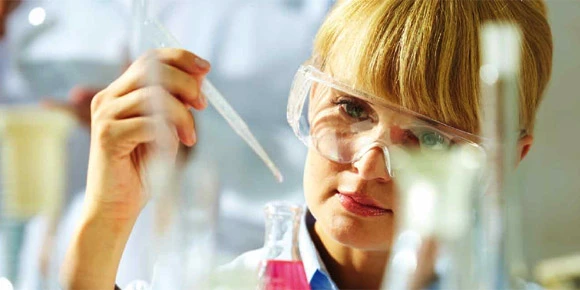Innovation thanks to analytics
Adlershof turns into “Analytic City”
Analytics has a long tradition in Adlershof. The Leibniz-Institut für Analytische Wissenschaften (ISAS) and the Federal Institute for Materials Research and Testing (BAM) are working towards refining this profile and help turning Adlershof into “Analytic City”.
It was analytics that found carbamazepine in the Teltow Canal. Carbamazepine, an anticonvulsant in the treatment of epilepsy, is not broken down in sewage clarification – just like the substances caffeine and musk, which can also be found in rivers and bathing lakes. Ulrich Panne is on the trail of these so called emerging pollutants. He is Professor of Instrumental Analytical Chemistry at the Humboldt-Universität zu Berlin and Director of BAM Department 1. One of his key research fields deals with immunoassays, or methods serving to determine even the tiniest quantities of bioactive substances. “The advantage of immunoassays,” explained Panne, “is that they provide fast and low cost analyses of many samples.”
The methods developed by BAM can be applied in many ways. Whether it’s about detecting aflatoxin on ice cream or mycotoxins in flour, or whether manufacturers of generics want to ensure that every pill contains exactly the same agent – analytics provides the key each and every time. Here precision is the be all and end all. “The minimum detection limits are sinking all the time,” explained Panne. “Today we can even detect a single molecule.”
New challenges for measuring technology are also the business of Norbert Esser, Professor of Physics (Surface Boundary and Surface Analytics) at the TU Berlin and Managing Director of the Leibniz-Institut für Analytische Wissenschaften (ISAS) “We’re advancing into ever smaller dimensions,” he explained. In doing so, ISAS works with analytical spectroscopy and in this manner can analyse even the smallest quantities of material. “Our target,” confided Esser, “is to gain quantitative findings on the composition of substances.” His work also focuses on thin films and their key role in semiconductor electronics. In refining its measuring technology,ISAS also cooperates with the industry. One “beacon” of such a joint venture, as Esser puts it, is continuum source AAS, an optical absorption method developed with Analytik Jena AG.
“We need the transfer of innovation,” concluded Esser with conviction. “By developing new analytical methods we safeguard quality in Germany as an industrial location.” Esser also sees these interactions between science and industry taking shape at the Adlershof location. “In the field of analytics, Adlershof is Germany’s number one address,” he concluded – all the requirements to turn Adlershof into “Analytic City” of international acclaim.
SALSA also contributes to this aim – the School of Analytical Sciences Adlershof was set up as part of the Excellence Initiative. Ulrich Panne is one of the spokesmen – and he describes SALSA as a “great example of how the Adlershof location works.”
By Christian Hunziker for Adlershof Special
